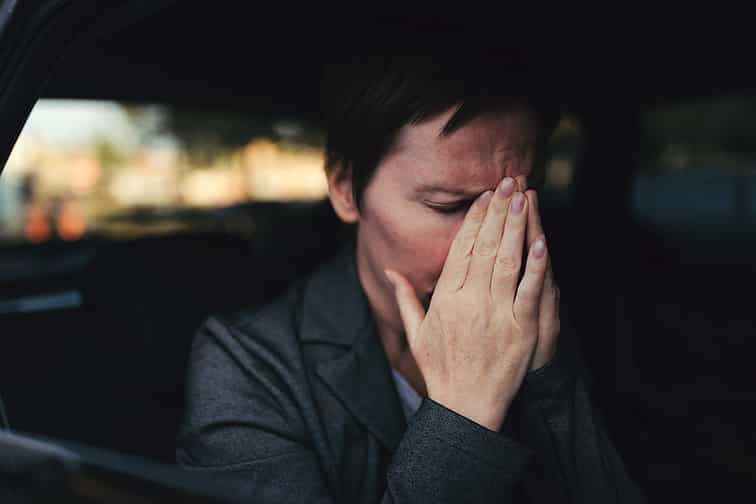As a GP of almost 30 years with a special interest in Women’s Health, Dr Paula Stanley has managed a lot of patients with PMS. This month she gives some insight into the condition and why it’s so important that it’s recognised and treated.

Myth Busting
Premenstrual syndrome or PMS is very much a real condition. For many years even the medical profession was sceptical and some regarded PMS as a behavioural issue: something women used as an excuse for grumpy behaviour. PMS does not occur because of any hormone imbalance, excess or deficiency. PMS is not linked with any fertility issues. There is no blood test for PMS, it is a clinical diagnosis made following a detailed medical consultation with the patient. PMDD or Premenstrual Dysmorphic disorder is not the same as PMS but is the most severe form of PMS.
Prevalence
Peak prevalence of severe PMS is in the 35 to 45 year age group. Studies have shown that 24 per cent or almost one in four women suffer from moderate PMS. Severe PMS affects five to eight per cent of the general population but can be as high as 23 per cent of women in the Perimenopause. A survey by The International Association for Premenstrual Disorders, IAPMD, published on World Suicide Day 2021 showed that 86 per cent of women with PMDD considered suicide and 30 per cent reported at least one attempt in their lifetime. Both PMS and PMDD are more likely in women who have suffered previous emotional or physical abuse.
Types and Definition
PMS is in fact made up of a few different syndromes and can be divided into: Core Premenstrual disorders and Variants.
Core Premenstrual Disorders occur in women with normal or ovulatory menstrual cycles.
PMDD or Premenstrual dysphoric disorder is the most severe form of Core Premenstrual disorder. A required diagnostic criteria for PMDD is that symptoms affect a woman’s ability to function, interfering with her life at work, at home and socially. Another diagnostic marker for PMDD is that it is not related to or exaggerated by any other medical conditions.
Variant Premenstrual Disorders is the term used to describe PMS symptoms that occur in a non ovulatory setting such as:
• as a side effects of a progestogen medication, either in contraceptive or HRT medication.
• in the Perimenopause when many cycles are non ovulatory and hormone levels can fluctuate wildly.
• PMS without menstruation such as when a woman has had a hysterectomy.
Symptoms
Physical symptoms are abdominal bloating, appetite changes, insomnia or excessive sleeping, sore, swollen and tender breasts and headaches. Headaches can be normal headaches or migraines. Some might get a change in their bowels, often diarrhoea and some experience hot flushes.
Psychological symptoms are varied and during the 25 years I ran a Women’s Health Clinic in my London practice, I found the following to be a good way of explaining these to a patient or more importantly to a partner or friend who might attend with them and has never experienced PMS: ‘the emotions you experience are extreme versions of normal emotions that come on extremely rapidly and at times will be completely out of your control: something on the TV that is a little sad will have you sobbing uncontrollably for an hour and you might even have suicidal thoughts. Minor irritants send you into an uncontrollable rage of anger sometimes triggering thoughts of violence. Slight anxiety can rapidly escalate to panic attacks or even paranoia.’
Women often describe these feelings as overwhelming and what is important for those around the woman to realise is that in the moment these emotions can be impossible to control. It can be quite frightening and I have had patients come to me terrified that they are developing bipolar or some other form of severe mental illness.
What is happening?
A woman with a four-week cycle usually ovulates about 14 days after the first day of her period. The two weeks after ovulation is called the luteal phase of her cycle and this is when PMS symptoms are experienced. Importantly for diagnosis, there is complete resolution of all symptoms with onset of menstruation.
During the luteal phase of a woman’s cycle, her oestrogen is falling and her progesterone is rising. It is thought that it is the woman’s response to her own normal hormone fluctuations at that time that causes the symptoms.
In particular, it is thought that the upsurge in progesterone is an important factor. Proof that PMS is related to the ovarian activity of ovulation is the fact that it does not occur before puberty, during pregnancy or after the menopause.
As is the case for a lot of Women’s Health conditions, not a lot of time or money has been put into research for PMS, unlike the millions invested into developing viagra. PMS falls in the gap between gynaecology and psychiatry and neither camp seems hugely keen to research it. What also complicates the design of any studies is the huge placebo effect of any therapy on PMS symptoms.
It is thought there is genetic predisposition and some sort of increased sensitivity to what are normal hormonal fluctuations in sufferers. A really interesting publication in 2007 in Biological Psychiatry revealed the existence of a sex hormone sensitive gene complex. This is a game changer because it established that women with PMDD have an intrinsic difference in their molecular apparatus for response to sex hormones and not just, as many medics had previously thought, an emotional behaviour problem that they should be able to control. There has also been a link shown between postnatal depression, PMS and depression in the menopause.
Diagnosis
There is no lab or blood test for PMS. First and foremost, I need to listen to my patient, take a detailed history, go through all her symptoms and in particular whether the symptoms go away when her period starts. To diagnose PMS, it is recommended a patient fill out a symptoms diary for at least two cycles, emphasising that this be done after her PMS phase has passed, ie after her period starts. I have found that most of the time the patient herself gives me her diagnosis when telling me: “and then once my period starts, I am normal again, doctor!”
If onset of a woman’s period does not resolve all her symptoms, I need to consider alternative diagnoses such as bipolar affective disorder. It is important to add that women can have both a mental illness and PMS and in this situation they should also be under the care of a mental health team.
What I am able to do is reassure the woman sitting in front of me, who feels desperately guilty for biting the head off her husband/kids/work colleagues three days a month for years and is convinced that there is something intrinsically wrong with her. She lives in fear of that time in the month coming around again and it affects her whole life. Most upsettingly, PMS is something everyone feels is alright to make jokes about which, believe me, does not help.
I am able to tell her ‘there is nothing wrong with you emotionally or psychiatrically. Your physical and emotional symptoms are real and valid and represent a diagnosis of PMS. That PMS is a condition almost one in four women suffer from and is caused by increased sensitivity to your own normal hormone fluctuations after ovulation and not because you are a horrible cow….and that it is possible to get rid of it.’
Treatment
Lifestyle changes are important, as excess caffeine or alcohol can worsen PMS symptoms. Regular exercise also helps. Some vitamins have been shown to help such as Vitamin B6 but not in doses exceeding 50mg per day. No evidence of benefit has been shown for zinc or magnesium supplements. Oil of evening primrose, active ingredient gamolenic acid, is helpful for bothersome breast symptoms in PMS but not for other symptoms. There is some evidence that other vitamins and supplements might help such as calcium, isoflavones (soya derivatives), Agnus Cactus and St John’s Wort hypericum). However, St John’s wort interacts with many medications, in particular the contraceptive pill.
Because PMS symptoms are caused by hormone changes triggered by ovulation, it can be treated by switching off the normal cycle. This is best achieved by taking the combined oral contraceptive pill or COC, which contain two hormones, oestrogen and a progestogen. COC switches off ovulation, preventing the upsurge in progesterone in the luteal phase. Some older progestogens such as norethisterone and levonorgestrel are a little testosterone-like chemically and can actually cause PMS-type symptoms as a side effect. It is therefore recommended we avoid using COCs that contain these when treating PMS. COCs containing the progestogen drospirenone such as Yasmin, Eloine and Cilest are recommended first line for PMS. It is recommended to use COC without a break to avoid pill withdrawal PMS symptoms. Where oestrogen containing pill is contraindicated such as in a woman who gets migraine with aura or who has a history of DVT or leg clot, a progestogen-only contraceptive can have the same effect of switching off ovulation, although not as reliably as COC.
SSRI, serotonin reuptake inhibitors, are non-hormonal medications licensed to treat PMS. You might know SSRIs as the Prozac group of medicines. Studies have shown that taking SSRI either continuously or just for the two weeks of the luteal phase is equally effective. SSRI can be used along with COC. In my clinical practice, I often start SSRI straight away while waiting for the COC to work, then stop it later when the patient feels her symptoms are much better.
The Mirena or hormone-containing coil also has a place in managing PMS.
Where COC fails to improve symptoms, I do suggest Mirena coil. By itself this can help but importantly having a Mirena coil in place allows me to safely prescribe oestrogen therapy on top as a patch or gel, as this will improve PMS symptoms by suppressing ovulation.
Where the above treatments fails, referral to a gynaecologist specialising in PMS may be indicated.
Moving forward
What is needed is increased awareness of PMS both by patients and by the medical profession. I did not receive any PMS training in medical school, during my six month hospital obstetrics and gynaecology rotation or during my GP training scheme but had to seek it out. As a member of the British Menopause Society, I have been able to access further and specialist level learning on PMS.
As I have said in previous articles here, I strongly believe that women’s health needs are best met in the primary care setting by her GP. As GP s, we are the ones who see women from menarche to menopause: from her first period to her last and beyond. If a woman has a mixture of physical and emotional symptoms as described above, that seem to come and go, she should go and see her GP.
With the recent further expansion of the GP Visit card, hopefully more women will be encouraged to book an appointment for issues they previously thought too insignificant to bother the GP with or not worth the €60 fee.
The following websites on PMS may be useful: www.iapmd.org/toolkit and www.pms.org.uk



